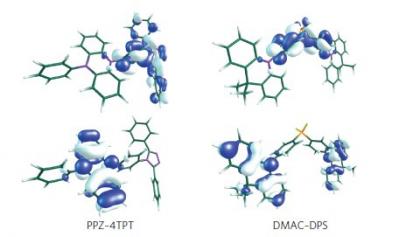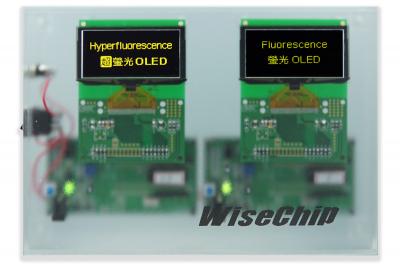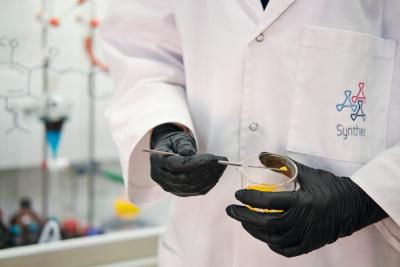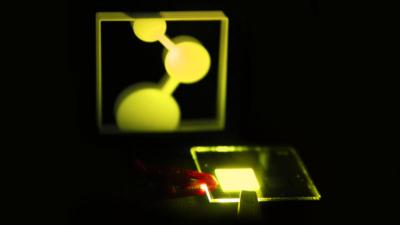TADF, or Thermally Activated Delayed Fluorescence, is a relatively new class of OLED emitter materials that promise efficient and long-lifetime performance without any heavy metals. TADF research started at around 2012, originally at Kyushu University in Japan and today many academic groups and several commercial companies are developing TADF materials.

The main reason companies are interested in TADF emission is that it could lead to an efficient and long-lasting blue OLED emitter - something that hasn't been yet achieved by other means (mainly - UDC's Phosphorescent OLED emitter technology). In recent years companies initiated commercial development of red, green and yellow TADF emitters as these can offer a lower cost alternative to UDC's PHOLEDs materials.
TADF is sometimes referred to as the 3rd-generation OLED emitter technology - with the 1st-gen being the original fluorescent emitters and the 2nd-gen phosphorescent (PHOLED) ones. One of the main disadvantages of TADF emitters, though, is the relatively wide emission spectrum - which results in low color purity. It was found that mixing a TADF emitter with a fluorescent emitter results in a high-efficiency system that also has a narrow spectrum. This resulted in the development of so-called hyper-fluorescence (HF) emitter systems - now called 4th-Gen OLED emitters and these have high promise and it seems as if most development today is focused on these hybrid emitter systems.
Kyulux
The most exciting announcement recently was Wisechip's launch of the world's first TADF / Hyperfluoresence display, a 2.7" 128x64 yellow PMOLED. This panel offers a brightness of 220 nites - 2.5 times the brightness of Wisechip's fluorescence yellow PMOLED. The lifetime achieved by this material is 50,000 hours. The producer of the HF material is Kyulux and hopefully Wisechip will start offering the panels commercially soon.

In June 2019 Kyulux announced its Series B round, raising $31.8 million from several companies and VCs. Kyulux is using the funds to accelerate its product development - which includes blue OLED emitters in addition to red, green and yellow. In March 2019 Kyulux updated on its latest TADF device that achieves 200 hours of lifetime (LT95 at 1000 nits) and an EQE of 22% (at 1000 nits). The color point is 470 nm (which is not deep-enough blue, note).
Cynora
Germany-based Cynora is focusing on the development of blue OLED emitters. In October 2018 Cynora extended its cooperation with LG Display to develop deep-blue OLED emitters. In May 2019 Cynora announced its Series C funding round, raising $25 million from investors in Asia, Europe and the US. Since 2008, Cynora raised $80 million.

The company recently announced a new CEO and changed its near and mid-term strategy by focusing on the development of two new undisclosed products for the display market, with the launch planned for 2020 and 2021. The long-term objective is still the commercialization of Cynora's TADF materials in about 2 years.
Cynora's latest deep-blue material specification was presented in May 2018 (the company did not provide a material update since) - with a CIEy of 0.14, EQE of 20% and a lifetime of 20 hours LT97 at 700 nits. Cynora says that its TADF materials are suitable for both self-emitting or what it refers to as co-emitting approaches (which includes Hyperfluorescence).
Idemitsu Kosan
Idemitsu Kosan started looking into TADF emitters as early as 2016, as the company decided this could be a viable technology for next-generation high-efficiency blue OLED materials. In December 2019 the company announced that together with Toray Industries, it has developed a red OLED device that is the world's most efficient emitter at 46 cd/A. The device uses a TADF emitter combined with red fluorescent materials (which likely means this is a Hyperfluorescence device).

Idemitsu and Toray has been collaborating on OLED material development since 2017. This new device uses Idemitsu's TADF material combined with Toray's new red fluorescent material. The two companies say that this new material provides the same results as currently used red phosphorescent devices, and the plan is now to "drive forward to secure adoption of these materials" in mobile and TV applications. See here for more information on this new device.
Others
There are other groups and companies also researchers TADF materials. In October 2019 we reported on Noctiluca , a newly-founded Polish startup that develops a novel TADF material compound. Noctiluca tells us that its team consists of chemists, who were providing high purity, advanced optoelectronics chemicals for many years. Noctiluca’'s proprietary emitters are divided in two groups - the first group is small-molecules emitters, mostly blue color while the second group are soluble blue, green and red emitters suitable for ink-jet printing. Noctiluca did not yet publish its material properties but it says that early synthesized emitters exhibit very promising properties and the company is now raising its second seed round.
Universal Display, the leading global emitter supplier, never acknowledged a TADF development project, but over the years we have seen the company awarded with several TADF patents. At least some (if not all) of the patents originate from UDC's BASF OLED IP acquisition - so we are not sure yet whether UDC actually has an active TADF project.
Research activities
There are many research activities that aim to develop new TADF emitters or make use of TADF emission in novel device structures or applications. For example in July 2019 we reported on a Max Planck Institute for Polymer Research (MPI-P) research project that developed an efficient OLED device that is comprised of a single organic material layer - replacing the normal stack of 5-7 layers in modern OLED devices.The MPI-P researchers managed to create this OLED device by using a TADF material (CzDBA, diboron based TADF) and by using a newly developed charge injection strategy.

In March 2018, researchers from Taiwan's National Tsing Hua University (NTHU) developed a new TADF OLED emitter material that maintains its high efficiency at high luminance. The researchers say that this new material is the world's most efficient TADF emitter at high brightness.
The EU has, over the years, launched several projects that involve TADF emitters - Project HyperOLED in 2017, and the 2015 project Phebe. In December 2017 the EU funded a project called LEO that aims to develop efficient and cost-effective OLED lighting technologies - based on Cynora's TADF emitters.
Finally an important development for the OLED emitter market was Samsung Display's announcement in October 2019 that it is investing $10.8 billion to establish QD-OLED TV production lines. Samsung's architecture is based on blue OLED emitters (with printed QD conversion layers) which means that an efficient blue emitter will be highly critical for Samsung - even more so than LG with its yellow+blue OLED TV platform - which will also of course benefit from a highly efficient blue. It's no wonder that Samsung Display and LG Display both invested in Cynora and Kyulux.


You should check what is happening at Noctiluca now. They just announced going for patent of its 5th generation emitters (combine PST and PSF) to make longest lifetime for blue , much longer than 2nd and 3rd gen.